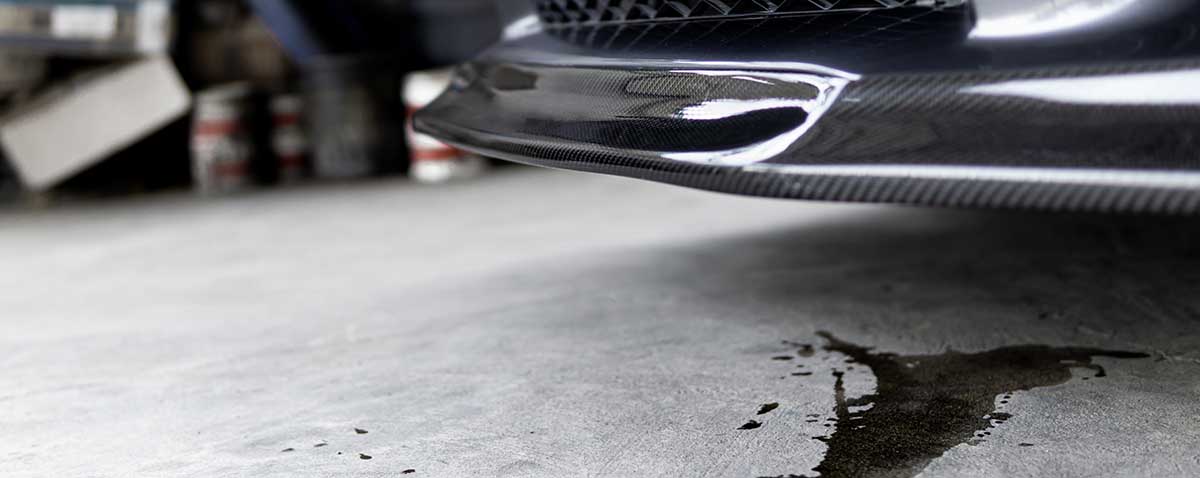Nobody wants to see a huge puddle of some kind of unidentified car fluid pooled on the garage floor. If you walk out to your car and see a leak under it, you might think to yourself, “should I drive my car? Will my car blow up while I’m driving around Phoenix?”
Just like most complicated machines they are filled with several different fluids to allow them to function properly, your car has a variety of liquids coursing through it so that it can run at its best. Unfortunately, our cars will sometimes spring leaks. Knowing how to identify the puddle under your car can help you prevent mechanical problems from turning into a blown engine and a major auto repair shop bill.
Here are all of the leaks that your car may spring, and how to identify them:
Gasoline Leak
Gas leaks are easy to identify. If the puddle under your car smells like gas, then it’s almost certainly gas. But just because you have a gas leak doesn’t mean that your car is about to explode. Some people drive around for months leaking gas without any problems. The biggest risk is usually just losing money from wasted gas. However, fire and explosions is still a slight risk, so it’s important to get any gas leaks taken care of immediately. Gas can leak from your gas tank, fuel pump, or fuel lines.
Oil Leak
Another common fluid leak is motor oil. If your car leaks while parked and leaves a puddle of oil under it, you should get it fixed as soon as possible. An oil leak can easily lead to low oil levels in your car, which can cause serious engine damage. New oil is golden yellow in color, while old oil is dark brown. An oil leak can come from several sources, including but not limited to worn gaskets, oil filter not attached correctly, corroded oil lines, an improperly secured oil plug, and high oil pressure. Your car may not leak oil in drips, but seep slowly from various parts in the engine. Oil seepage is common in high-mileage cars, and usually is not serious enough to cause damage between oil changes. Just keep an eye on it, and if it starts to get more serious, get it looked at as soon as you can.
Coolant Leak
Coolant, also known as antifreeze, usually has a bright green color, although it can also be bright orange or pink. It has a slightly sticky, viscous feel. Coolant is one of the most common leaks on cars, and although it is not the most serious leak, it should be fixed as soon as possible. Coolant is responsible for keeping your engine from overheating, and if all of your coolant leaks out, your engine can easily overheat and die, leaving you stranded, causing metal parts to warp, and necessitating an expensive engine rebuild. Coolant is also extremely toxic to animals, and it has a sweet smell and taste which makes it attractive to them. Therefore, if you have pets, you should not let them anywhere near a coolant leak, and get it fixed as soon as possible so that they don’t end up licking it up and dying. Coolant usually leaks from the radiator, radiator hoses, heater hoses, or engine core plugs.
Brake Fluid Leak
Brake fluid is clear to yellowish, with a medium thickness and slight oily feel,. If you even suspect that your car is leaking brake fluid, do not try to drive it. Get it towed to a mechanic immediately. Even a few drops of brake fluid leaking out can cause brake failure. Fortunately, brake fluid leaks are rare. If you do have one, you’ll usually find it near the wheels or in the area directly under the brake pedal.
Automatic Transmission Fluid Leak
Automatic transmission fluid is a light red or pink color when new, and dark red or brownish when it’s old. It is thick and oily – old transmission fluid may be hard to tell apart from oil. Transmission fluid is a lubricant in your car’s transmission so that it shifts smoothly and correctly. It also functions as coolant so that your transmission doesn’t overheat. If your transmission fluid gets dangerously low, it is very likely that you will grind or burn your transmission beyond repair. Rebuilding or replacing a transmission will almost always cost more than $1,000 – usually several thousand dollars – so you should definitely get a leak fixed as soon as you notice it. Transmission fluid leaks will usually be near the front or middle of the car, near the transmission filler tube, drain hole, selector shaft, or between the transmission and engine.
Power Steering Fluid Leak
Many cars actually use automatic transmission fluid as their power steering fluid, so if you notice a reddish stain under your car and your steering has started groaning or becoming harder to steer, you most likely have a power steering leak. Some cars use a power steering fluid specifically designed for power steering, which will be slightly yellowish and thick. Check your owner’s manual to find out what your car uses for power steering fluid. Power steering leaks will be towards the front of the car, usually from the power steering reservoir, power steering pump, or hoses connecting the power steering system. If you run your system dry for too long, the additional friction can damage your pump beyond repair, and you will have to get it replaced, so you should get power steering leaks fixed as soon as possible, or at least keep an eye on the fluid level – plus, it will make parking your car way easier.
Water Leak
The leak that most people freak out about isn’t actually a leak – it’s just water condensation from your air conditioner. If it’s a hot day and you’ve had your A/C running, it should be steadily dripping water. This is completely normal and nothing to worry about.
Windshield Washer Solvent Leak
Windshield wiper fluid is usually blue, although it can also be green or orange. It feels almost like water. Leaking wiper fluid will not affect your engine in any way, but it will make it harder to clean your windshield after a bird bombs it or you drive through a swarm of flies.
If your car has sprung a leak, contact Perez Auto Repair online via phone 602-269-3576 or stop into our facility located at 429 S. 35th Ave, Phoenix, AZ 85009.


